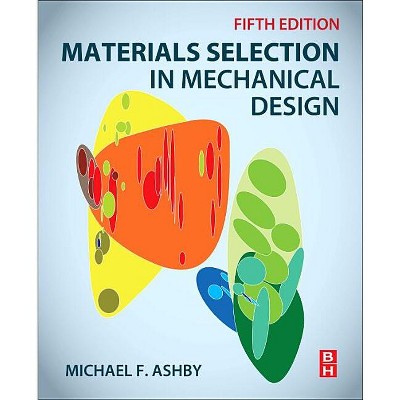Sponsored

Mechanical Design of Structural Materials in Animals - by John M Gosline (Hardcover)
In Stock
Sponsored
About this item
Highlights
- Mechanical Design of Structural Materials in Animals explores the principles underlying how molecules interact to produce the functional attributes of biological materials: their strength and stiffness, ability to absorb and store energy, and ability to resist the fatigue that accrues through a lifetime of physical insults.
- About the Author: John M. Gosline (1943-2016) was a professor of zoology at the University of British Columbia from 1973 to 2008.
- 400 Pages
- Science, Life Sciences
Description
About the Book
"Mechanical Design of Structural Materials in Animals explores the principles underlying how molecules interact to produce the functional attributes of biological materials: their strength and stiffness, ability to absorb and store energy, and ability to resist the fatigue that accrues through a lifetime of physical insults. These attributes play a central role in determining the size and shape of animals, the ways in which they can move, and how they interact with their environment. By showing how structural materials have been designed by evolution, John Gosline sheds important light on how animals work. Gosline elucidates the pertinent theories for how molecules are arranged into macromolecular structures and how those structures are then built up into whole organisms. In particular, Gosline develops the theory of discontinuous, fiber-reinforced composites, which he employs in a grand synthesis to explain the properties of everything from the body wall of sea anemones to spiders' silks and insect cuticles, tendons, ligaments, and bones. Although the theories are examined in depth, Gosline's elegant discussion makes them accessible to anyone with an interest in the mechanics of life. Focusing on the materials from which animals are constructed, this book answers fundamental questions about mechanical properties in nature."--Book Synopsis
Mechanical Design of Structural Materials in Animals explores the principles underlying how molecules interact to produce the functional attributes of biological materials: their strength and stiffness, ability to absorb and store energy, and ability to resist the fatigue that accrues through a lifetime of physical insults. These attributes play a central role in determining the size and shape of animals, the ways in which they can move, and how they interact with their environment. By showing how structural materials have been designed by evolution, John Gosline sheds important light on how animals work.
Gosline elucidates the pertinent theories for how molecules are arranged into macromolecular structures and how those structures are then built up into whole organisms. In particular, Gosline develops the theory of discontinuous, fiber-reinforced composites, which he employs in a grand synthesis to explain the properties of everything from the body wall of sea anemones to spiders' silks and insect cuticles, tendons, ligaments, and bones. Although the theories are examined in depth, Gosline's elegant discussion makes them accessible to anyone with an interest in the mechanics of life. Focusing on the materials from which animals are constructed, this book answers fundamental questions about mechanical properties in nature.From the Back Cover
"Combining a limited number of basic components, animals have developed a tremendous diversity of materials, most of which have not been scientifically examined or understood fully. Even the most detailed information about their chemical composition and genetic background has not answered questions about mechanical performance. In this outstanding book, Gosline shows us how to analyze the relationship between structure and function and how to exploit this knowledge to design original bioinspired materials."--Stanislav Gorb, Kiel University
"This excellent book is useful for teaching materials science or biomechanics to biologists, as well as for giving materials scientists and engineers a biological or bioinspirational perspective."--Peter Fratzl, Max Planck Institute of Colloids and Interfaces
"This book argues that adaptive design in load-bearing biological materials necessarily involves contributions at multiple length and time scales ranging from nanometers and microseconds to meters and years. Well-supported through his analysis of case studies, Gosline succeeds in reconciling and integrating contributions to function at different scales as no other writer has done to date."--J. Herbert Waite, University of California, Santa Barbara
Review Quotes
"Combining a limited number of basic components, animals have developed a tremendous diversity of materials, most of which have not been scientifically examined or understood fully. Even the most detailed information about their chemical composition and genetic background has not answered questions about mechanical performance. In this outstanding book, Gosline shows us how to analyze the relationship between structure and function and how to exploit this knowledge to design original bioinspired materials."--Stanislav Gorb, Kiel University
"This book argues that adaptive design in load-bearing biological materials necessarily involves contributions at multiple length and time scales ranging from nanometers and microseconds to meters and years. Well-supported through his analysis of case studies, Gosline succeeds in reconciling and integrating contributions to function at different scales as no other writer has done to date."--J. Herbert Waite, University of California, Santa Barbara
"This excellent book is useful for teaching materials science or biomechanics to biologists, as well as for giving materials scientists and engineers a biological or bioinspirational perspective."--Peter Fratzl, Max Planck Institute of Colloids and Interfaces
About the Author
John M. Gosline (1943-2016) was a professor of zoology at the University of British Columbia from 1973 to 2008. He is the coauthor of Mechanical Design in Organisms (Princeton).Shipping details
Return details
Trending Non-Fiction


















